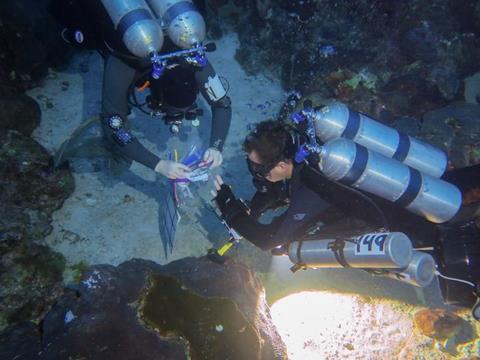Since the 1970s, coral reefs in the Florida Keys National Marine Sanctuary (FKNMS) have experienced catastrophic declines in coral cover, with as much as a 50% reduction between 1998 and 2011 alone.

Although coral reefs within the FKNMS have been heavily studied, research in the mesophotic zone, which extends from about 100 to 500 feet deep, has historically been more limited in this region.
READ MORE: Microplastics found in all three parts of coral anatomy
READ MORE: Remarkable diversity in heat tolerance can help protect coral reefs
Mesophotic coral ecosystems have the potential to be buffered from anthropogenic stressors due to their depth and/or relative isolation from shore in many regions. Moreover, mesophotic coral ecosystems may also function as refuges for depth-generalist coral species, providing viable larvae to degraded shallow reefs after isolated episodic disturbance events. In the FKNMS, mesophotic corals have largely avoided the damage caused by bleaching and stony coral tissue loss disease, so they could be a key source of genetic diversity for shallow reefs in the region.
Blushing coral star
Using the blushing coral star (Stephanocoenia intersepta), found throughout the Western Atlantic, researchers from Florida Atlantic University’s Harbor Branch Oceanographic Institute investigated how coral populations at different depths and locations may be related or “connected” to each other. Using genomic DNA analyses, they explored genetic diversity, differences and connectivity among blushing coral star populations and their symbiotic algal partners using SNP genotyping and ITS2 sequencing.
“The blushing star coral has a wide range both in depth and geography, which makes it a great species for studying how populations at various depths and locations are linked,” said Ryan Eckert, first author and a Ph.D. candidate at FAU Harbor Branch. “Although blushing star corals are less common on shallow reefs throughout their geographic range, they become more abundant and cover more area in the mesophotic zone.”
Four genetic lineages
Results of the study, published in the journal Heredity and featured on the cover, revealed four distinct genetic lineages of blushing star coral. At the sites sampled, the two main genetic lineages of the blushing star coral exhibited strong genetic connectivity between shallow and mesophotic populations. Two shallow-specific lineages showed lower genetic diversity and higher inbreeding as compared to the two depth-generalist lineages. The analysis also indicated that mesophotic reefs are key reproductive sources, especially in the Lower and Upper Keys.
“Corals from deeper, mesophotic zones have a significant potential to help replenish and restore the declining shallow reefs in Florida Keys National Marine Sanctuary,” said Joshua Voss, Ph.D., senior author, principal investigator of the study, and an associate research professor at FAU Harbor Branch. “Plus, important expansions planned in the ‘FKNMS Restoration Blueprint’ include additional protections for mesophotic corals throughout the Keys. Given that coral cover in the region has been decreasing since the 1970s, these findings and new management advances offer promising opportunities for some level of coral reef recovery.”
Inbred individuals
According to Eckert, the lower diversity and higher levels of inbred individuals across shallow specific lineages are quite worrisome and may portend potential risks moving forward, especially for conservation and restoration efforts.
“However, even if these deeper corals can’t directly repopulate the shallow reefs with viable larvae in the future, they could still be valuable for creating a ‘seed bank’ or for rescue and breeding programs in land-based nurseries to support ongoing and future restoration efforts,” said Eckert.
The distinct cryptic lineages of blushing star coral, with little mixing despite their overlap in the same areas, suggest some level of reproductive isolation. Reproductive isolation between lineages could be due to factors like differing spawning times or high inbreeding rates from localized fertilization. These patterns could be influenced by larval behavioral traits and settlement preferences, contributing to the lower genetic diversity in the shallow blushing coral star populations.
Protecting populations
“By recognizing and characterizing the genetic biodiversity across different coral lineages, we can better manage and protect coral populations, especially as we face ongoing and future environmental challenges,” said Voss. “This approach ensures that coral conservation and restoration efforts are informed by a more comprehensive understanding of genetic diversity, essential for maintaining the resilience and health of our coral reef ecosystems.”
The study’s co-authors included Alexis Sturm, Ph.D.; Ashley Carreiro, research laboratory manager; and Allison Klein, a Ph.D. candidate; all from the Voss Laboratory at FAU Harbor Branch.
This research was supported by NOAA Ocean Exploration and Research awarded to Voss
(NA14OAR4320260) through the Cooperative Institute for Ocean Exploration, Research, and Technology, and by the NOAA National Center for Coastal Ocean Science (NA18NOS4780166) awarded to Voss and S. Herrera through the Connectivity of Coral Ecosystems in the Northwest Gulf of Mexico project.







No comments yet